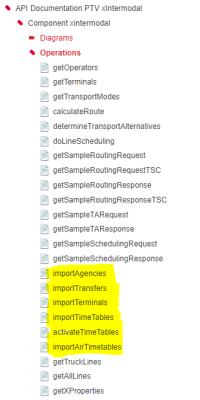by Bernd Welter » Fri Dec 03, 2021 8:20 am
Cheers,
these days the topic of intermodal routing gets more and more attention. Some partners asked me about the difference between xRoute's and xIntermodal's handling of ferries. Therefore I decided to gather the core benefits in this thread. The trigger for the questions was the
Considering Combined Transports article in the xServer2 documentation. Here we go:
- In xRoute an intermodal object such as a ferry or a piggyback is more or less just a combination of pickup and delivery location (and its polyline) and a static "driving period" (and no distance, btw). So when such a ferry appears in the result incl. a specific "time of arrival at the ferry entrance" the router immediately continues the trip though in real life there's a high probability of a waiting period. Within xIntermodal such an object also considers flexible timetable and this would return the additional waiting time according to the ferry schedule.
- The number of intermodal objects in xRoute is fixed within the used map. In xIntermodal a user is enabled to import own data records for Agencies, Transfers, Timetables, Terminals, ...

- screenshot from the xIntermodal API
- With xIntermodal you can restrict the means of transport for the alternatives: excludedTransportModeCodes
- With xIntermodal you can link a GTFSRoute to a GTFSAgency: excludedOperatorCodes
As some users have negotiated contracts with those agencies you could filter an xIntermodal route to such agencies (on client side)
Though these statements may sound simple they open a wide range of possibilities.
To be continued / extended,
Bernd
Cheers,
these days the topic of intermodal routing gets more and more attention. Some partners asked me about the difference between xRoute's and xIntermodal's handling of ferries. Therefore I decided to gather the core benefits in this thread. The trigger for the questions was the [url=https://xserver2.cloud.ptvgroup.com/dashboard/Default.htm#UseCases/Routing/UC_Considering_Combined_Transport.htm%3FTocPath%3DIntegration%2520Samples%7CRouting%7C_____7]Considering Combined Transports article[/url] in the xServer2 documentation. Here we go:
[list][*]In xRoute an intermodal object such as a ferry or a piggyback is more or less just a combination of pickup and delivery location (and its polyline) and a static "driving period" (and no distance, btw). So when such a ferry appears in the result incl. a specific "time of arrival at the ferry entrance" the router immediately continues the trip though in real life there's a high probability of a waiting period. Within [color=#FF0000]xIntermodal such an object also considers flexible timetable[/color] and this would return the additional waiting time according to the ferry schedule.
[*]The number of intermodal objects in xRoute is fixed within the used map. In [color=#FF0000]xIntermodal a user is enabled to import own data records[/color] for Agencies, Transfers, Timetables, Terminals, ... [attachment=0]xIntermodalAPI.PNG[/attachment]
[*]With xIntermodal you can restrict the means of transport for the alternatives: [color=#FF0000]excludedTransportModeCodes[/color]
[*]With xIntermodal you can link a GTFSRoute to a GTFSAgency: [color=#FF0000]excludedOperatorCodes[/color]
As some users have negotiated contracts with those agencies you could filter an xIntermodal route to such agencies (on client side)[/list]
Though these statements may sound simple they open a wide range of possibilities.
To be continued / extended,
Bernd